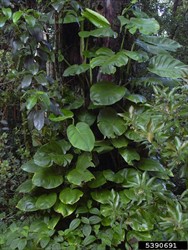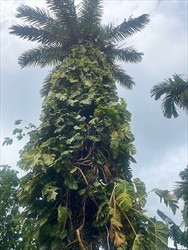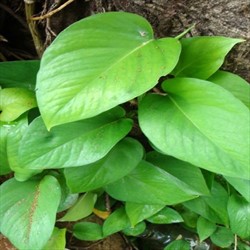Taro vine. It is also known as centipede tongavine, devil's ivy, golden pothos, monstera, dragon-tail plant, and money plant.
Pacific Pests, Pathogens, Weeds & Pesticides - Online edition
Pacific Pests, Pathogens, Weeds & Pesticides
Taro vine (550)
Epipremnum pinnatum. Previously, it was known as Epipremnum aureum, Epipremnum pinnatum cv. Aureum, Monstera pinnnatum, Pothos pinnatus. It has a confused taxonomy. Note, Epipremnum aureum is treated as a synonym of Epipremnum pinnatum by some taxonomists, although others believe it to be more robust. Epipremnum species are members of the Araceae.
Asia, Africa, North (Hawaii), South and Central America, the Caribbean, Oceania. It is recorded from Australia, Cook Islands, Federated States of Micronesia, Fiji, French Polynesia, Guam, Kiribati, Marshall Islands, Nauru, New Caledonia, Palau, Papua New Guinea, Solomon Islands, Tonga, Vanuatu, and Wallis and Futuna. Its native range extends from Asia to northern Australia. Because of its confused taxonomy, there are many locations given for its origin: Asia, Australia, French Polynesia, and Solomon Islands.
A perennial vine of the tropics and subtropics, invasive in many Pacific island countries in particular, forming dense communities, damaging to native ecosystems. It grows along the ground in search of trees to climb resulting in the smothering of mature native forest, preventing sunlight from reaching plants in the understory. Disturbed areas and roadsides are also invaded. It is an epiphyte, a plant that grows on another; it has rootlets from the stems that attach to trunks and branches (Photos 1-3). If eaten, taro vine can cause mild to severe poisoning.
Epipremnum pinnatum grows in clays, loams, and sandy soils, with pH 4-6. It is tolerant of drought, shade and high rainfall (upper limit 3500 mm annually).
Stems, green, flexible, 6-8 m long, 2-4 cm diameter, with aerial roots fastening to host. Leaves, alternate along the stems, green or variegated, large, egg-shaped, broader at the base with pointed tips, up to 60 cm long and 45 cm wide (much less when young or grown as houseplants) (Photos 4&5). Leaf stalks up to 35 cm. Variegated leaves have irregular yellow mottles and bands (Photo 5). Leaf blades become divided when old, often to the central vein, giving them a compound-leaf look. Flowers from the axils of leaves, like those of taro, with sheath around a central spike, about 15 cm long by 3 cm diameter, densely packed with small florets. Fruits contain 1-2 seeds. Flowers not often seen.
All parts contain needle-like calcium oxalate crystals. If plant are chewed or eaten, there may be immediate pain or a burning sensation with swelling of lips, mouth, tongue and throat. The sap may cause contact dermatitis and eye irritation.
Spread occurs vegetatively from cuttings and tiny stem fragments, both of which stay viable for long periods. Where seeds are produced, the fruits are likely to be taken and dispersed by birds. Long distance, but undocumented spread, has occurred associated with domestic and international trade in taro vine as an ornamental and for medicinal purposes.
Classified as an environmental weed, highly invasive in the Galapagos islands, Tanzania, St. Lucia, Hawaii, French Polynesia and the Federated States of Micronesia. In Florida, it is a Category II weed as designated by the Florida Invasive Species Council, meaning it is recognised as being invasive, but it has not disrupted native plant communities. If eaten, taro vine can cause mild to severe poisoning.
Used as an ornamental and medicinally in southeast Asia to treat rheumatism, cancer and dysentery.
BIOSECURITY
The risk of further introductions of taro vine is high. It is frequently used as an ornamental in gardens and the aureum (golden or variegated) variety is grown as a house plant worldwide (usually under the name dragon's tail). Epipremnum aureum and Epipremnum pinnatum are available for sale on the Internet.
BIOLOGICAL CONTROL
The severe disruption to Pacific Island ecosystems caused by taro vine and the lack of effective ways to manage the weed provides a case for investigating the feasibility of biological control.
CULTURAL CONTROL
Physical & Mechanical:
- Hand-pulling isolated plants or small infestations is possible, but labour intensive. Make sure all stem and tuber pieces are collected to prevent regrowth. It will need to be done repeatedly over an extended period. (Note, the method often fails as it leaves pieces high in the canopy which regrow.)
CHEMICAL CONTROL
Both foliar spray or cut stump/paint treatments are likely to be effective, BUT herbicide may also kill the tree on which taro vine is growing. The herbicide passes into the host via the roots of taro vine.
Where damage to the host tree is not an issue, tryclopyr or glyphosate can be used:
- Foliar spray: on young plants, use diluted product following manufacturers' instructions. Read the label.
- Cut stump/paint: on mature plants, cut stems just above ground level and brush or spray them immediately.
--------------------
Note, EU approval to use glyphosate ended in December 2022, but has been extended by one year to 15 December 2023.
____________________
When using a pesticide, always wear protective clothing and follow the instructions on the product label, such as dosage, timing of application, and pre-harvest interval. Recommendations will vary with the crop and system of cultivation. Expert advice on the most appropriate herbicides to use should always be sought from local agricultural authorities.
AUTHOR Konrad Englberger & Grahame Jackson
Information from CABI (2012) Epipremnum (centipede tongavine). Crop Protection Compendium. (https://www.cabidigitallibrary.org/doi/10.1079/cabicompendium.50410); and Identity crisis for a weed of the Pacific (Undated) Manaaki Whenua Landcare Research. (https://www.landcareresearch.co.nz/publications/weed-biocontrol/weed-biocontrol-articles/identity-crisis-for-a-weed-of-the-pacific/); and from Pothos (Epipremnum) (Undated) Children's Health Queensland Hospital and Health Service. Queensland Government. (https://www.childrens.health.qld.gov.au/poisonous-plant-pothos-epipremnum/); and from Epipremnum pinnatum 'Aureum' Nicolson, Araceae (2010) Pacific Island Ecosystems at Risk (PIER). (http://www.hear.org/pier/species/epipremnum_pinnatum_aureum.htm). Photo 1 Forest and Kim Starr, Starr Environmental, Bugwood.org.
Produced with support from the Australian Centre for International Agricultural Research under project HORT/2016/185: Responding to emerging pest and disease threats to horticulture in the Pacific islands, implemented by the University of Queensland and the Secretariat of the Pacific.








